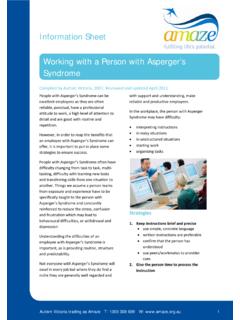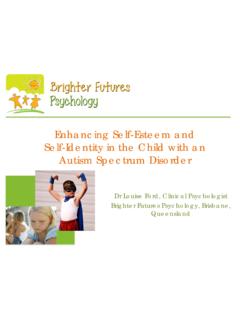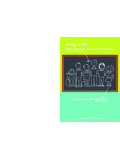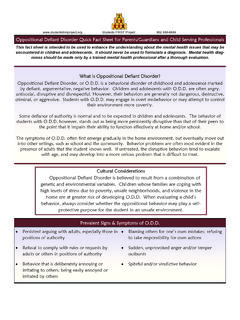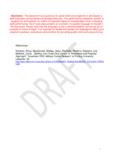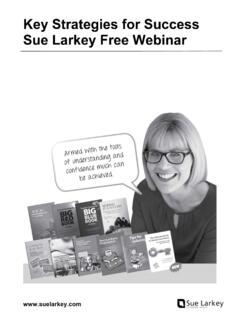Transcription of Information Sheet Toileting Resources for Children with ...
1 Toileting Resources for Children with Autism Spectrum Disorder Information Sheet Prepara on General Health: It may be helpful before star ng your toilet training program to have a discussion with your GP or Paediatrician about your child s general health. This will assure you that your child s intake of fluids and dietary fibre is sufficient for urina on and regular bowel rou nes. Time: Designate a block of me to toilet training. This will mean that the training will be constant and give your child an opportunity to learn this new skill set. The amount of me required may depend on your child s learning needs. Signs that your child is ready Children typically begin to show signs of bladder and bowel control at around 2 years of age (Con nence Founda on of Australia, 2010). Children with Au sm Spectrum Disorder, some of these signs can appear between 2 5 years of age (Wheeler, 1998). These include: Showing an interest Following a parent, sibling or family member to the bathroom They may have a dry nappy for up to two hours Your child may remove their nappy Awareness of a wet or soiled nappy Can sit between 2 5 minutes at a me If your child is unable to remain unsoiled or dry for a 1 to 2 hour period but s ll shows some of the other signs of readiness, it may be possible to commence toilet training (Wheeler, 1998).
2 Through habit training which is also known as toilet ming (going to the toilet at a fixed me), monitoring food and drink, and reinforcement, toile ng is a skill that can be taught. Prerequisite Skills The Con nence Founda on of Australia (2010) describes in detail ( with tasks broken down into an easy table) the pre requisite skills for toilet training. They include: Mobility: Can your child get to the toilet? Si ng: Can they sit for approximately 2 minutes at a me? For a child with an ASD this could mean they can be engaged in an ac vity for 2 minutes. Communica on: Can they communicate their Prepared by Amaze (Au sm Victoria), June 2013 Toilet training is seen by all parents as an important developmental stage for their child. For a parent of a child with Au sm Spectrum Disorder (ASD) this will take pa ence, understanding and observa on of the signs of readiness to move toward independent toile ng. Amaze (Au sm Victoria) T: 1300 308 699 W: 1 need for the toilet?
3 Dressing: Can they remove their clothing independently to use the toilet? These skills may need to be taught explicitly to a child with ASD before commencing toilet training. It may be important to teach your child to undress using loose fi ng, elas c band trousers or shorts, or skirt. Dressing your child in underwear with their favourite cartoon character on it may increase their desire to learn this skill. Visual prompts, such as using a photo of the toilet, will assist with communica on. When it is me for the toilet, take the photo with your child to the toilet, so they learn to associate the picture with the object. Si ng for two minutes can be encouraged by reading their favourite book and building up concentra on that way. Reinforce good si ng with another desired item, such as TV me or a favourite clip, whilst on the toilet. The reinforcement should be immediate (where possible). Strategies for Toilet Training Sue Larkey (2012) suggests that when Children are compliant, they are ready to start toilet training.
4 Compliance could be imita ng a parent s ac on, or being able to follow one step instruc on such as clap hands . As transi oning is an issue for many Children with ASD, many toilet training programs recommend not using a po y, but using a toilet training seat instead. Toilet training seats are an insert that sits under the toilet seat to make the hole smaller and more comfortable for the child. They can be purchased from most shops that sell baby/toddler items. Some can be purchased with handles, to increase the child s independence. Most professionals also agree that a child should move straight into underpants during the day, and only wear a night nappy. This will decrease the likelihood of your child holding on to void in their nappy. It also makes undressing for the toilet much easier. Before commencing toilet training, change your child s nappy in the same room as the toilet. This will aid with your child associa ng being wet or soiled with the toilet. A er commencing the program, change your child s night me nappy in the toilet, and follow the washing hands rou ne as you would a er using the toilet.
5 Children can be taught the en re rou ne of toile ng at the one me. This involves: Removing clothing Wiping Dressing Washing hands Even if your child can only complete some of these steps, it is important that the rou ne is followed so using the toilet then becomes one process. Begin with the least amount of guidance and increase as needed. This will ensure your child become more independent sooner. Visual schedules, where the steps of the task are set out in pictures, may help remind or prompt your child of what steps come next. Some steps may need to be broken down even further, such as hand washing. One visual card per step, turn on the tap, use soap, etc. Once Children have mastered the basic rou ne, they may only need reminding for some parts, wiping, or drying hands. Some parents may leave a visual schedule in the loca on where it is required, such as next to the bathroom sink to act as a prompt for hand washing. Reward your child for using the toilet. Your child will not only feel good, but this will assist with teaching them the steps.
6 The reward should be immediate, so your child then associates the reward to their success at toile ng. Sensory Issues A large number of Children with ASD have sensory issues. This may cause them to be more sensi ve or less sensi ve to their environment. Toilet training may place extra demands on a child with sensory issues. There are a number of things to consider: Your child may miss the sensa on of wearing a nappy. It may help to cut a hole in the back of Amaze (Au sm Victoria) T: 1300 308 699 W: 2 the nappy, to allow your child to s ll void into the toilet, with the sensa on of the nappy. You can then very gradually increase the size of the hole over me The height of the seat and the feeling of not having their feet on the floor might be an issue. A step may make your child feel more comfortable Your child may prefer a padded toilet set Environment: Temperature, light, size of the room Access to toilet Sensa on of their own body/fluids Boys: Stand or sit?
7 When toilet training a boy, it is important that they begin their training si ng on the toilet to do both wee and poo. This simplifies the process and both skills are learnt simultaneously. If your son doesn t understand the difference between doing a poo or wee, then standing up to wee may not be a goal. Once both of these skills are taught, it will then be me for your son to learn to wee standing. The easiest way for a boy to learn is to watch his dad or older brother do this. Modeling is an important learning tool. If this is not possible, a video such as Tom s Toilet Triumph (from the Are You Ready? DVD) is an excellent anima on about a boy learning to use the toilet. Things to Remember Toilet training is a skill that takes me to learn. For Children with ASD it is important to be consistent with the program. If you need further advice or support regarding toilet training, or con nence, please contact the following services: Your child s GP or Paediatrician Occupa onal Therapists Parentline 1300 301 300 Na onal Con nence Helpline: 1800 330 066 References and Resources Are you Ready?
8 A Toilet Training Package This resource includes a DVD, as men oned above and also contains a resource for parents, including data collec on tables for monitoring progress. Con nence Founda on of Australia, (2010). One Step at a Time: A parent s guide to toilet skills for Children with special needs. The PDF of this program can be downloaded from: h Wheeler, M. (1998). Toilet Training for Individuals with Au sm and Related Disorders: A comprehensive guide for parents and teachers. Sue Larkey (retrieved September 2012): h Note: The Amaze Library offers a great selec on of books and Resources specifically rela ng to every aspect of Au sm Spectrum Disorder. The library is available to current members of Amaze. For more details, contact our librarian on 03 9657 1636 or via email: _____ 2013 Amaze (Au sm Victoria). Permission is granted for the content of this informa on Sheet to be reproduced in its en rety, provided Amaze (Au sm Victoria) is acknowledged as the source and the website address is given.
9 Amaze (Au sm Victoria) T: 1300 308 699 W: 3
